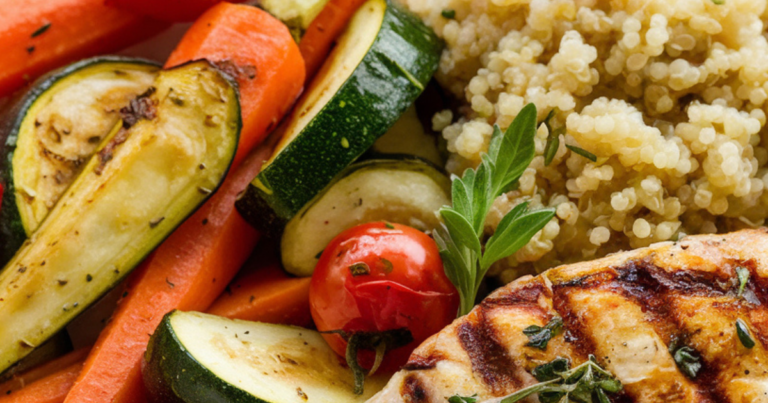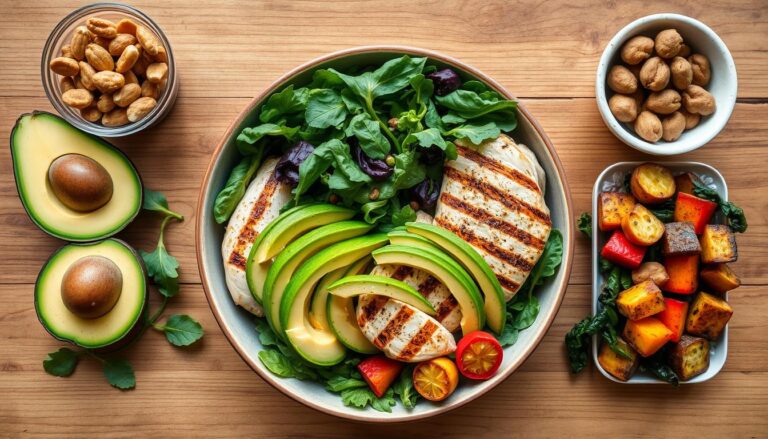Comprehensive Guide to the Nutritional Value of Green Peas
Green peas, known scientifically as Pisum sativum, are more than just a colorful addition to food. They are packed with vitamins, minerals, and a lot of dietary fiber. This makes them a top choice for many families in the United States. This guide will dive into the health perks of green peas, their nutritional profile, and how to add them to a healthy diet.
Introduction to Green Peas
What are green peas? These small, round legumes are bright green and grow in pods. They come from the Mediterranean and are loved in many homes in the United States. Green peas add color and sweetness to dishes.
There are mainly three types of green peas: snap peas, snow peas, and garden peas. Each type has its own taste and texture. Snap peas have crunchy pods and seeds, while snow peas are flat and great in stir-fries. Garden peas are the ones you usually find frozen or canned, and they’re perfect as a side dish or in other recipes.
Green peas are packed with vitamins, minerals, and nutrients. How they’re grown affects their quality and taste. Knowing about green peas and their types helps us see why they’re so popular in diets around the world.
| Green Pea Type | Description | Common Uses |
|---|---|---|
| Snap Peas | Sweet flavor with crisp texture; edible pods. | Salads, snacks, and stir-fries. |
| Snow Peas | Flat pods with tender seeds; slightly sweet. | Stir-fries, Chinese dishes, and salads. |
| Garden Peas | Round, sweet peas in inedible pods. | Side dishes, soups, and casseroles. |
Health Benefits of Green Peas
Green peas are packed with health benefits that boost overall well-being. They are full of antioxidants in green peas that fight oxidative stress and inflammation. These tiny legumes are also rich in vitamins A, C, and K, which boost the immune system and keep skin healthy.
The green peas nutrition is impressive, with minerals like magnesium, zinc, and iron. These nutrients are key for muscle function, energy, and bone health. Green peas also help with digestion thanks to their high fiber content, which keeps bowel movements regular and prevents constipation.
Green peas also help with weight management. Their fiber content makes you feel full, which can lower daily calorie intake. Eating green peas regularly may also reduce the risk of heart disease and type 2 diabetes, according to studies.
Here’s a table showing some of the main health benefits of green peas:
| Benefit | Description |
|---|---|
| Rich in Antioxidants | Protects against oxidative stress and inflammation. |
| Supports Immune Function | Contains vitamins A, C, and K that strengthen the immune system. |
| Aids Digestive Health | High in fiber, promoting regularity and reducing constipation. |
| Weight Management | High fiber content increases satiety, helping control calorie intake. |
| Reduces Chronic Disease Risk | May lower risks of heart disease and type 2 diabetes. |
Nutritional Value of Green Peas
Green peas are packed with nutrients and offer many health benefits. Knowing the nutritional value of green peas is key for those wanting to eat more plant-based foods. This section explores the main reasons green peas are great for any meal.
Caloric Content
Green peas have about 62 calories per 100 grams. This makes them a low-calorie choice. You can add them to your diet without worrying about too many calories.
Macronutrient Breakdown
Looking at the macronutrients in green peas shows they are well-balanced. Each serving has:
- 5 g of protein
- 0.4 g of fat
- 11 g of carbohydrates
This mix of nutrients makes meals more nutritious and supports different dietary needs.
Vitamins and Minerals
The vitamins and minerals in green peas are vital for health. They are especially high in:
- Folate, important for cell function and growth
- Vitamin K, crucial for blood clotting and bone health
- Manganese, key for metabolism and fighting off free radicals
These nutrients help prevent deficiencies and support the body’s functions. This makes green peas a nutritional powerhouse.
Green Peas and Dietary Fiber
Dietary fiber is key for good health. It helps with digestion, lowers cholesterol, and fights chronic diseases. Eating foods high in fiber can help you feel full, which is good for weight control.
Fiber’s benefits are many, making it a must-have in a healthy diet.
Importance of Fiber in Diet
Fiber comes in two types: soluble and insoluble. Soluble fiber helps control blood sugar. Insoluble fiber makes your bowel movements regular. Eating enough fiber from green peas boosts digestive health and lowers heart disease and diabetes risks.
Nutritionists say women should eat about 25 grams of fiber daily. Men should aim for 38 grams. This highlights the need for fiber-rich foods in our diet.
How Green Peas Contribute to Daily Fiber Needs
Green peas are packed with about 5 grams of fiber per 100 grams. They’re great for anyone looking to boost their fiber intake. Adding green peas to meals not only tastes good but also offers fiber’s health perks.
To meet fiber needs, mix green peas with other fiber sources like whole grains, fruits, and veggies. This approach supports nutritional goals and overall health.
Green Peas in a Balanced Diet
Green peas are key to a balanced diet, adding flavor and essential nutrients. They are low in calories but rich in vitamins, minerals, and protein. This makes them a great choice for healthy meals.
Adding green peas to your meals is easy and enjoyable. You can mix them into salads, blend them in soups, or serve them as a side. Their versatility makes them fit well with many cooking styles, from classic dishes to modern plant-based recipes.
“Legumes, such as green peas, are pivotal in crafting a healthy diet with legumes, contributing significantly to dietary variety and nutrient density.”
Here are some tips to get the most from green peas in your diet:
- Include green peas in stir-fries for added color and nutrition.
- Add them to smoothies for a protein boost.
- Use them as a base for dips or spreads, enhancing both texture and flavor.
For those on a plant-based diet, green peas are a great protein source. They offer a sustainable option compared to animal products. Including them in your diet supports the environment and your health.
| Nutritional Component | Amount per 100g |
|---|---|
| Calories | 81 |
| Protein | 5.4g |
| Fiber | 5.7g |
| Vitamin A | 765 IU |
| Vitamin C | 40mg |
| Iron | 1.5mg |
In summary, adding green peas to your diet boosts your health and supports sustainable eating. By incorporating them into your meals, you can enjoy a wide range of flavors and nutritional benefits.
How to Incorporate Green Peas into Meals
Green peas are a versatile ingredient that can add flavor and nutrition to your meals. They are best when cooked right, bringing out their natural sweetness and vibrant color. Here are some effective cooking methods and delicious recipes to inspire your cooking.
Cooking Methods
There are several ways to cook green peas, each with its own benefits. These methods can enhance their taste and texture.
- Steaming: Keeps nutrients and color bright, great for a side dish.
- Boiling: Fast and easy, perfect for soups and stews.
- Sautéing: Adds flavor with oil and seasonings, ideal for stir-fries.
Recipes Featuring Green Peas
Adding green peas to your meals can be simple and rewarding. Here are some tasty recipes to try:
- Pea and Mint Soup: A refreshing mix of green peas and mint, perfect for hot days.
- Stir-Fried Green Peas and Carrots: Quick and healthy, pairs well with rice or noodles.
- Green Pea Salad: Fresh peas with arugula, feta, and lemon vinaigrette make a great side.
- Creamy Pea Risotto: Rich and comforting, easy to make.
- Green Peas Casserole: A hearty dish, great for family meals, with peas, cream, and cheese.
Trying out these recipes can make your meals better and add nutrition. Cooking green peas can make any dish more enjoyable and healthy.
| Cooking Method | Benefits | Best Dish Example |
|---|---|---|
| Steaming | Retains nutrients and color | Steamed Peas with Mint |
| Boiling | Quick and versatile | Pea Puree Soup |
| Sautéing | Flavorful and aromatic | Stir-Fried Peas with Garlic |
Conclusion
Green peas are packed with nutrients that make them great for a healthy diet. They are full of vitamins, minerals, and fiber. These are all important for staying healthy. Knowing the benefits of green peas helps people choose to eat them more often.
Eating green peas is not just about their taste. It’s about choosing a healthy lifestyle with plant-based foods. They are easy to add to many dishes. This makes meals healthier and tastier.
Green peas help a lot with digestion and blood sugar control. They show how important legumes are in our diet. Adding green peas to our meals can lead to better health and more nutrition.
FAQ
What are green peas and how are they categorized?
Green peas, also known as *Pisum sativum*, are small, round legumes. They are bright green in color. There are different types like snap peas, snow peas, and garden peas. Each type has its own flavor and texture.
What is the nutritional value of green peas?
Green peas are packed with nutrients. They have about 62 calories per 100 grams. They contain 5 g of protein, 0.4 g of fat, and 11 g of carbs. They also have vitamins and minerals like folate, vitamin K, and manganese.
What health benefits do green peas offer?
Green peas are full of antioxidants and vitamins A, C, and K. These support the immune system and overall health. They also have a lot of fiber, which is good for digestion and can help with weight management and reducing chronic disease risk.
How do green peas contribute to daily fiber intake?
Green peas have about 5 g of dietary fiber per 100 grams. They are a great source of fiber. Eating green peas can help meet your daily fiber needs, which is important for digestive health.
What are some healthy ways to incorporate green peas into meals?
Green peas are versatile and can be used in many dishes. They can be steamed, boiled, or sautéed. They add nutrition to salads, soups, casseroles, and stir-fries. Adding green peas to meals can make your diet more balanced and nutritious without adding too many calories.
Why are green peas considered a sustainable food choice?
Green peas are good for the environment and are a plant-based protein source. Eating legumes like green peas supports sustainable eating and a healthy lifestyle.
Are there any recipes that specifically highlight green peas?
Yes, there are many recipes that feature green peas. You can find refreshing salads, hearty soups, delicious casseroles, and tasty stir-fries. These recipes add variety to meals and make the most of green peas’ nutritional benefits.







